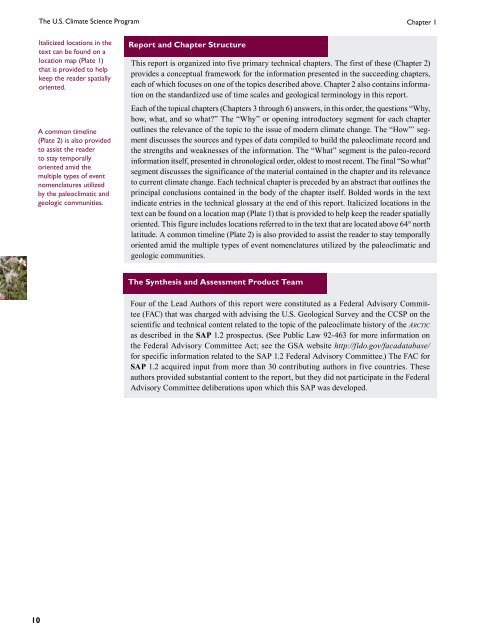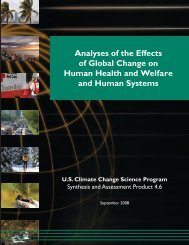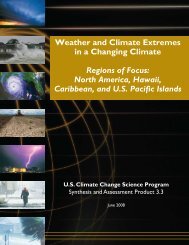Past Climate Variability and Change in the Arctic and at High Latitudes
Past Climate Variability and Change in the Arctic and at High Latitudes
Past Climate Variability and Change in the Arctic and at High Latitudes
You also want an ePaper? Increase the reach of your titles
YUMPU automatically turns print PDFs into web optimized ePapers that Google loves.
10<br />
The U.S. <strong>Clim<strong>at</strong>e</strong> Science Program Chapter 1<br />
Italicized loc<strong>at</strong>ions <strong>in</strong> <strong>the</strong><br />
text can be found on a<br />
loc<strong>at</strong>ion map (Pl<strong>at</strong>e 1)<br />
th<strong>at</strong> is provided to help<br />
keep <strong>the</strong> reader sp<strong>at</strong>ially<br />
oriented.<br />
A common timel<strong>in</strong>e<br />
(Pl<strong>at</strong>e 2) is also provided<br />
to assist <strong>the</strong> reader<br />
to stay temporally<br />
oriented amid <strong>the</strong><br />
multiple types of event<br />
nomencl<strong>at</strong>ures utilized<br />
by <strong>the</strong> paleoclim<strong>at</strong>ic <strong>and</strong><br />
geologic communities.<br />
Report <strong>and</strong> Chapter Structure<br />
This report is organized <strong>in</strong>to five primary technical chapters. The first of <strong>the</strong>se (Chapter 2)<br />
provides a conceptual framework for <strong>the</strong> <strong>in</strong>form<strong>at</strong>ion presented <strong>in</strong> <strong>the</strong> succeed<strong>in</strong>g chapters,<br />
each of which focuses on one of <strong>the</strong> topics described above. Chapter 2 also conta<strong>in</strong>s <strong>in</strong>form<strong>at</strong>ion<br />
on <strong>the</strong> st<strong>and</strong>ardized use of time scales <strong>and</strong> geological term<strong>in</strong>ology <strong>in</strong> this report.<br />
Each of <strong>the</strong> topical chapters (Chapters 3 through 6) answers, <strong>in</strong> this order, <strong>the</strong> questions “Why,<br />
how, wh<strong>at</strong>, <strong>and</strong> so wh<strong>at</strong>?” The “Why” or open<strong>in</strong>g <strong>in</strong>troductory segment for each chapter<br />
outl<strong>in</strong>es <strong>the</strong> relevance of <strong>the</strong> topic to <strong>the</strong> issue of modern clim<strong>at</strong>e change. The “How”’ segment<br />
discusses <strong>the</strong> sources <strong>and</strong> types of d<strong>at</strong>a compiled to build <strong>the</strong> paleoclim<strong>at</strong>e record <strong>and</strong><br />
<strong>the</strong> strengths <strong>and</strong> weaknesses of <strong>the</strong> <strong>in</strong>form<strong>at</strong>ion. The “Wh<strong>at</strong>” segment is <strong>the</strong> paleo-record<br />
<strong>in</strong>form<strong>at</strong>ion itself, presented <strong>in</strong> chronological order, oldest to most recent. The f<strong>in</strong>al “So wh<strong>at</strong>”<br />
segment discusses <strong>the</strong> significance of <strong>the</strong> m<strong>at</strong>erial conta<strong>in</strong>ed <strong>in</strong> <strong>the</strong> chapter <strong>and</strong> its relevance<br />
to current clim<strong>at</strong>e change. Each technical chapter is preceded by an abstract th<strong>at</strong> outl<strong>in</strong>es <strong>the</strong><br />
pr<strong>in</strong>cipal conclusions conta<strong>in</strong>ed <strong>in</strong> <strong>the</strong> body of <strong>the</strong> chapter itself. Bolded words <strong>in</strong> <strong>the</strong> text<br />
<strong>in</strong>dic<strong>at</strong>e entries <strong>in</strong> <strong>the</strong> technical glossary <strong>at</strong> <strong>the</strong> end of this report. Italicized loc<strong>at</strong>ions <strong>in</strong> <strong>the</strong><br />
text can be found on a loc<strong>at</strong>ion map (Pl<strong>at</strong>e 1) th<strong>at</strong> is provided to help keep <strong>the</strong> reader sp<strong>at</strong>ially<br />
oriented. This figure <strong>in</strong>cludes loc<strong>at</strong>ions referred to <strong>in</strong> <strong>the</strong> text th<strong>at</strong> are loc<strong>at</strong>ed above 64° north<br />
l<strong>at</strong>itude. A common timel<strong>in</strong>e (Pl<strong>at</strong>e 2) is also provided to assist <strong>the</strong> reader to stay temporally<br />
oriented amid <strong>the</strong> multiple types of event nomencl<strong>at</strong>ures utilized by <strong>the</strong> paleoclim<strong>at</strong>ic <strong>and</strong><br />
geologic communities.<br />
The Syn<strong>the</strong>sis <strong>and</strong> Assessment Product Team<br />
Four of <strong>the</strong> Lead Authors of this report were constituted as a Federal Advisory Committee<br />
(FAC) th<strong>at</strong> was charged with advis<strong>in</strong>g <strong>the</strong> U.S. Geological Survey <strong>and</strong> <strong>the</strong> CCSP on <strong>the</strong><br />
scientific <strong>and</strong> technical content rel<strong>at</strong>ed to <strong>the</strong> topic of <strong>the</strong> paleoclim<strong>at</strong>e history of <strong>the</strong> <strong>Arctic</strong><br />
as described <strong>in</strong> <strong>the</strong> SAP 1.2 prospectus. (See Public Law 92-463 for more <strong>in</strong>form<strong>at</strong>ion on<br />
<strong>the</strong> Federal Advisory Committee Act; see <strong>the</strong> GSA website http://fido.gov/facad<strong>at</strong>abase/<br />
for specific <strong>in</strong>form<strong>at</strong>ion rel<strong>at</strong>ed to <strong>the</strong> SAP 1.2 Federal Advisory Committee.) The FAC for<br />
SAP 1.2 acquired <strong>in</strong>put from more than 30 contribut<strong>in</strong>g authors <strong>in</strong> five countries. These<br />
authors provided substantial content to <strong>the</strong> report, but <strong>the</strong>y did not particip<strong>at</strong>e <strong>in</strong> <strong>the</strong> Federal<br />
Advisory Committee deliber<strong>at</strong>ions upon which this SAP was developed.




